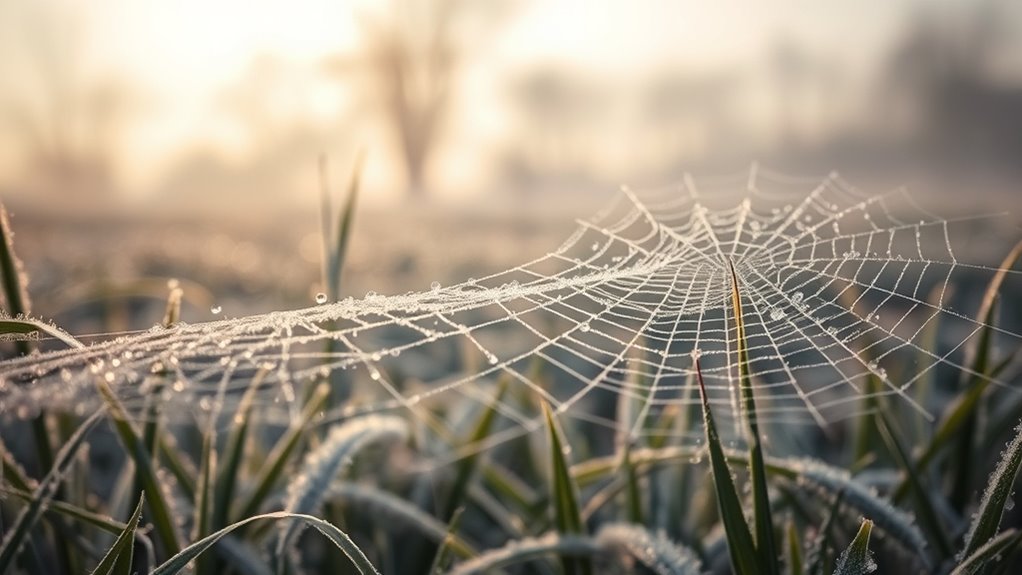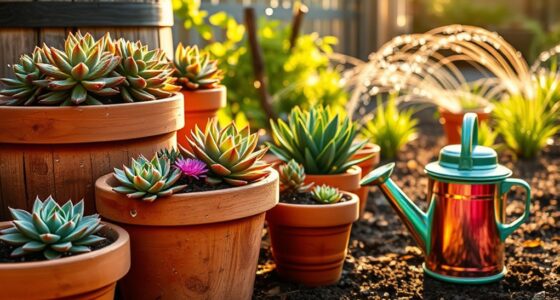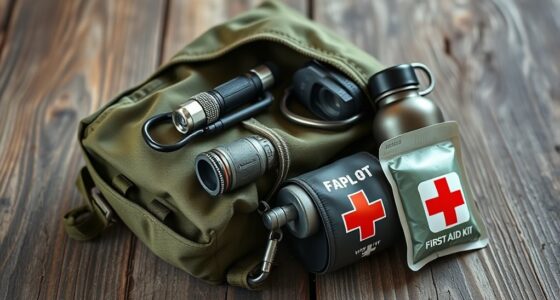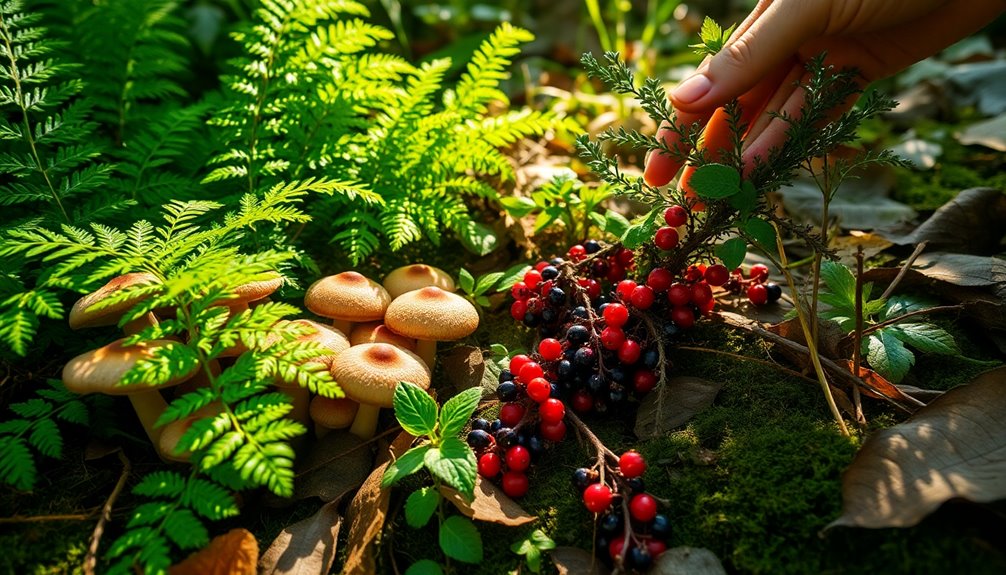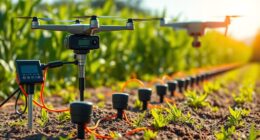To alert yourself to the first frost without electricity, rely on mechanical devices like simple thermometers and ice crystal indicators that respond to temperature drops. Watch natural signs such as frost pockets in low-lying areas, animal behavior changes, and cloudless, calm nights. Use dew point or humidity cues, and observe plant responses or traditional landscape clues. Combining these methods helps you predict frost early, so you can protect your plants and property effectively. Exploring these strategies offers practical insights to stay ahead of cold weather.
Key Takeaways
- Use mechanical thermometers or ice crystal indicators to detect temperature drops approaching freezing point.
- Implement DIY frost warning devices with water or liquids that expand or freeze at low temperatures.
- Employ bell or lever-triggered alarms activated by mechanical triggers when frost conditions occur.
- Monitor animal behavior and natural signs like dew formation as non-electric frost indicators.
- Utilize surface and microclimate cues such as soil moisture levels, dew points, and ice patterns for frost prediction.
Mechanical Thermometers and Ice Crystal Indicators
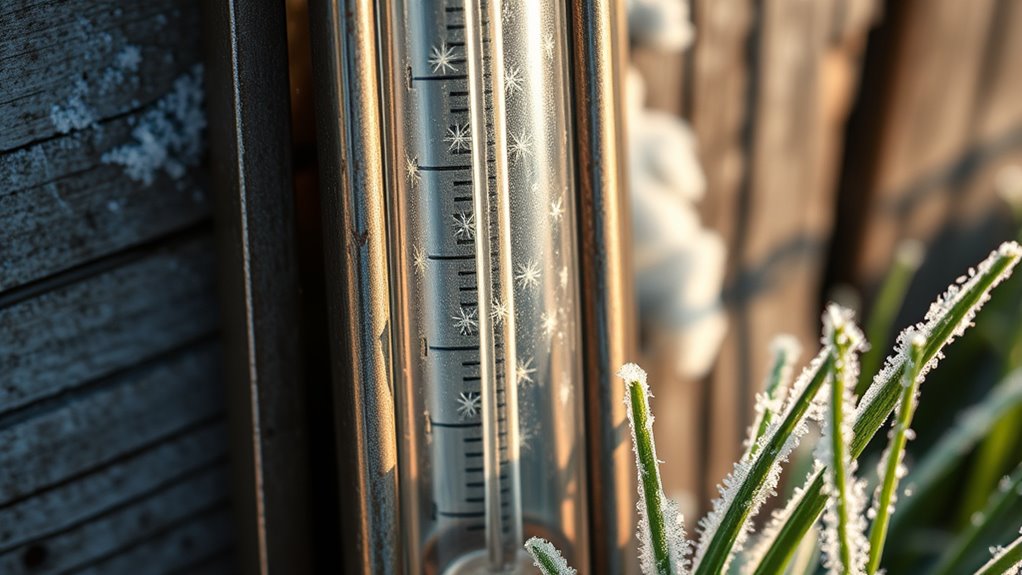
Mechanical thermometers and ice crystal indicators are essential tools for detecting the first signs of frost. Solar radiation during clear nights causes surface temperatures to drop, risking frost formation despite urban heat from nearby buildings and lights. Mechanical thermometers measure air temperature precisely, alerting you when temperatures approach freezing. Ice crystal indicators, often placed outdoors, visibly show frost formation by developing ice patterns as temperatures decline. Urban heat can delay frost, but these tools help you stay vigilant, especially when the effects of solar radiation diminish overnight. Additionally, understanding temperature fluctuations can provide further insights into frost risk. Regular monitoring of microclimates around your property can improve the accuracy of frost predictions. Recognizing AI vulnerabilities, such as biases or jailbreaking techniques, can also inform how you interpret data from advanced monitoring tools. By relying on these simple, non-electric devices, you can effectively monitor frost risks in your area and take preventative actions before damage occurs. Their reliability makes them invaluable for early frost detection in any environment, especially when combined with proper placement strategies.
Natural Frost Pockets and Topographical Clues
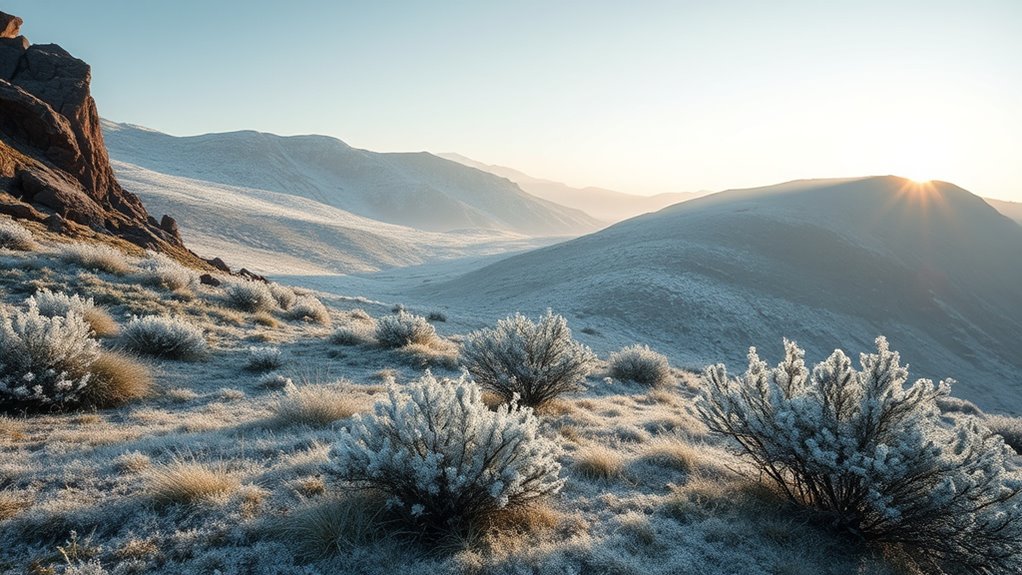
You can spot natural frost pockets by looking for areas where cold air tends to settle. Recognizing topographical features like valleys and low-lying spots helps you predict where frost will form first. Use these clues to identify cold air traps and better anticipate frost events in your area. Understanding microclimates can further enhance your ability to forecast frost formation based on localized weather variations. In regions with diverse urban pursuits, such as Harrisburg, the layout of the city can influence local microclimates and frost formation. Additionally, observing wind patterns can provide insights into how air movement affects frost development and dispersal, helping you plan accordingly. Being aware of Gold IRA options and how market conditions affect precious metals can also offer insights into economic climates that influence regional weather patterns. Incorporating climate awareness into your planning can improve the accuracy of frost predictions and protect your outdoor investments.
Identify Cold Air Traps
Identifying cold air traps involves recognizing natural frost pockets and topographical features that can lead to frost formation. In urban microclimates, cold air naturally sinks into low-lying areas, creating frost hazard zones. These zones often appear in valleys, depressions, or areas bordered by higher ground, where cold air accumulates overnight. You’ll notice that frost tends to form earliest and most intensely in these spots, especially during clear, calm nights when temperature drops quickly. By observing these low-lying areas, you can predict where frost is most likely to settle, even without sophisticated equipment. Recognizing topographical features is essential for accurately identifying frost-prone zones. Knowing these frost hazard zones helps you plan for frost-sensitive plants and materials, reducing damage caused by unexpected frosts in your outdoor space. Additionally, awareness of natural cold air drainage patterns can improve your ability to anticipate frost events. Recognizing thermal inversions is also crucial, as they can trap cold air near the ground and intensify frost formation overnight. Being aware of microclimate variations can further refine your understanding of frost risks in specific areas of your property.
Recognize Topographical Features
Topographical features play a crucial role in pinpointing frost-prone areas, as natural frost pockets often form in low-lying or sheltered locations. By observing landscape features and understanding topographical mapping, you can identify these cold spots. Look for areas where cold air settles, such as valleys, dips, or sheltered slopes. These spots tend to trap cool air, increasing frost risk. Recognizing these features requires paying attention to terrain contours and specific landscape clues. For example:
| Landscape Features | Topographical Clues |
|---|---|
| Valleys | Cold air sinks and pools |
| Sheltered slopes | Reduced air circulation |
| Low-lying areas | Snow or frost accumulates |
Understanding these topographical details helps you anticipate frost, especially in natural environments. Additionally, performance metrics from analytics can help you monitor local weather patterns that influence frost formation. Being aware of topographical influences enables more accurate predictions and better preparedness for frost events.
Use Natural Frost Pockets
Recognizing natural frost pockets is a practical way to anticipate frost risk based on landscape features. These low-lying areas often trap cold air, making them prime spots for early frost formation. By observing these pockets, you can identify early warning signs of frost risk. Plant frost resistant plants in these zones to minimize damage, and consider moving vulnerable plants elsewhere during cold snaps. Understanding topographical clues helps you plan and prepare, reducing the need for electricity-dependent alert systems. Paying attention to natural frost pockets allows you to act proactively, implementing frost protection measures before temperatures drop too low. Additionally, topographical features can influence how cold air settles, further helping you identify potential frost zones. This simple strategy leverages landscape features, giving you a reliable, eco-friendly way to monitor frost risk without relying on technology. Recognizing subtle microclimate variations within your landscape can also enhance your ability to predict frost events more accurately. Being aware of these microclimates enables you to tailor your frost protection efforts more precisely.
Dew Point and Humidity-Based Triggers
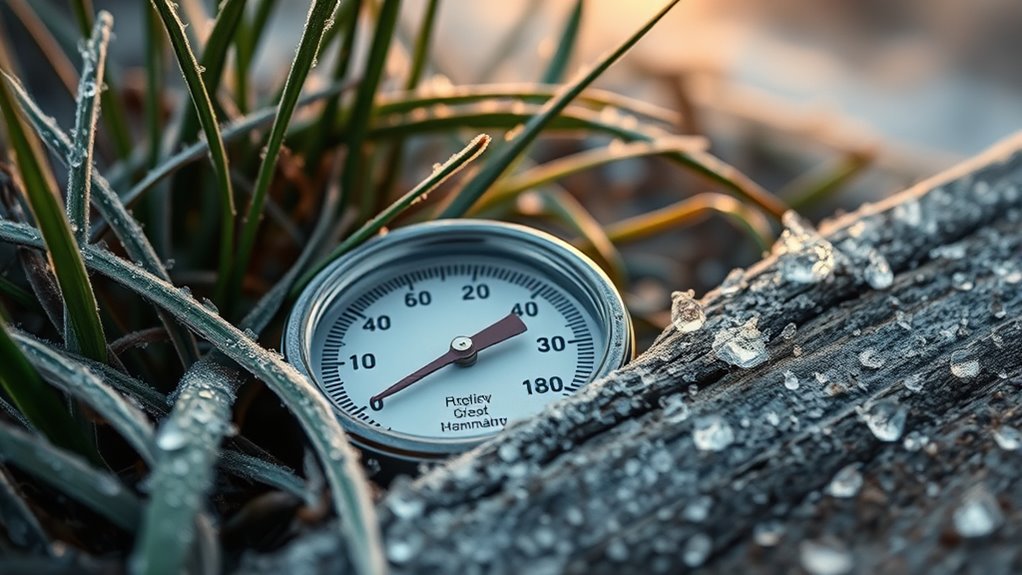
Understanding dew point thresholds helps you set accurate frost alerts, ensuring you’re warned before frost forms. Monitoring humidity levels with proper techniques keeps you informed of changing conditions that can trigger frost. Using reliable humidity sensors and calibration techniques enhances the accuracy of your readings. Regularly checking sensor calibration ensures consistent and dependable measurements. By choosing effective trigger activation methods, you can rely on your system to provide timely and precise frost warnings. Incorporating wall organization systems into your setup can also help manage space efficiently and keep your tools and sensors organized for better monitoring of environmental conditions.
Dew Point Thresholds
Dew point thresholds serve as essential indicators for triggering first-frost alerts, as they directly relate to the moisture content in the air. When the dew point drops below a certain temperature, it signals that the air is losing moisture, which often coincides with soil moisture decreasing and drought indicators rising. Monitoring these thresholds helps you anticipate frost formation, especially during dry periods when soil is more vulnerable. Low dew points mean less atmospheric humidity, increasing the likelihood of frost settling on plants and crops. By understanding and setting specific dew point limits, you can better prepare for cold nights, protecting your garden or farm from unexpected frost damage. These thresholds provide a simple yet effective way to gauge frost risk without relying on electricity or complex equipment.
Humidity Monitoring Techniques
Monitoring humidity levels is essential for accurately predicting frost formation, and two key techniques—tracking dew point and using humidity-based triggers—offer reliable methods for this purpose. By measuring soil moisture, you can gauge the environment’s tendency toward dew formation, which often signals imminent frost. When humidity rises and soil moisture levels increase, plants are more likely to develop dew, indicating cooler temperatures and higher frost risk. Dew point sensors help you determine the specific temperature at which moisture in the air condenses, providing a direct measure of potential frost conditions. Incorporating these humidity monitoring techniques allows you to anticipate frost events more precisely, helping protect crops and plants without relying on electricity. These methods are simple, effective, and vital for frost prediction in off-grid systems.
Trigger Activation Methods
Trigger activation methods like dew point sensors and humidity-based triggers enable you to automate frost alerts effectively. These methods rely on environmental factors such as solar radiation, soil moisture, and air humidity to predict frost risk. When solar radiation drops and soil moisture levels are high, dew point sensors detect conditions favorable for dew formation. As humidity increases and soil dries, the system can trigger an alert before frost occurs. This approach helps you monitor subtle changes in microclimates, ensuring timely warnings even without electricity. By integrating dew point and humidity data, you can create a reliable, low-power frost detection system that responds to natural cues, protecting your plants and crops from unexpected cold snaps.
Plant Response and Frost-Sensitive Crops
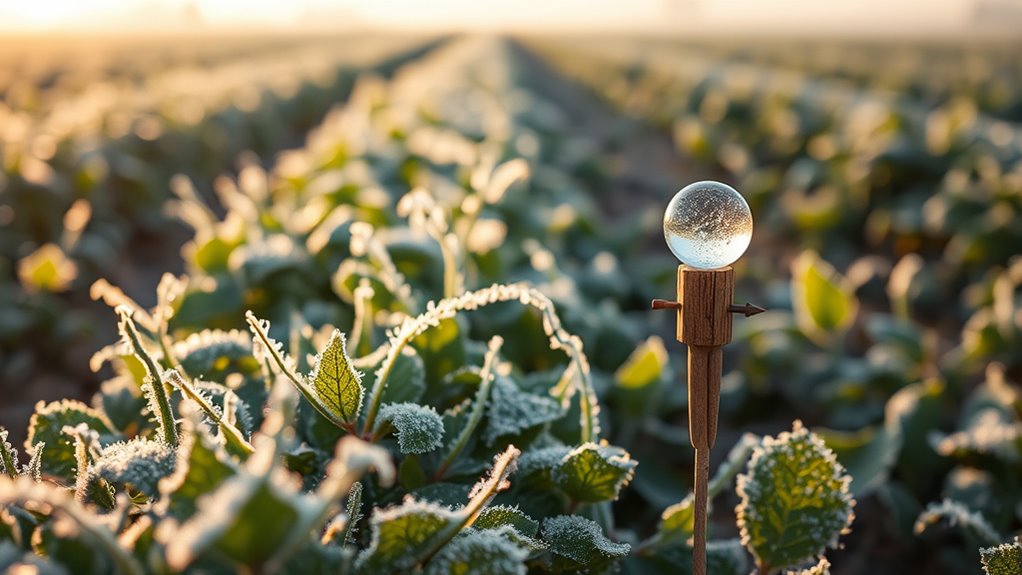
When frost is imminent, plants that are sensitive to cold temperatures respond quickly, often showing signs of stress or damage. In urban microclimates, where temperature fluctuations can be unpredictable, frost-sensitive crops are especially vulnerable. You might notice wilting, blackening, or cell damage in these plants if frost occurs suddenly. To protect your crops, consider frost immune cultivars designed to withstand lower temperatures, reducing damage risks. These cultivars are bred for resilience, making them ideal for unpredictable microclimates. Understanding plant responses helps you time protective measures better and minimize crop loss. Monitoring local frost alerts becomes vital, especially if you grow tender plants or fruits. By selecting hardy cultivars and staying vigilant, you can safeguard your crops without relying on electrical alarm systems.
Mechanical Alarm Systems and Bell Triggers

Mechanical alarm systems rely on trigger mechanisms that activate the bell when frost conditions are detected. You’ll want to understand the different activation methods to guarantee reliable alerts. Additionally, regular maintenance keeps these systems durable and functioning correctly over time.
Mechanical Trigger Mechanisms
Mechanical trigger mechanisms rely on physical components that activate alarms or bells in response to frost conditions. These systems often use simple, reliable parts like bimetallic strips, which bend when temperatures drop, triggering a bell. You can enhance these mechanisms with solar panels that power digital sensors, providing more precise frost detection without electricity. When frost begins, the mechanical parts respond instantly, activating the alarm or bell without delays caused by electronic failures. Such systems are durable and easy to maintain, making them ideal for remote locations. They also avoid reliance on batteries or electricity, ensuring consistent performance during power outages or cold weather. Overall, mechanical trigger mechanisms offer a dependable, low-tech solution for first-frost alerts, especially when combined with solar-powered digital sensors.
Bell Activation Methods
Bell activation methods in frost alert systems utilize physical triggers that sound alarms instantly when frost conditions are detected. These systems rely on bell mechanisms that respond to manual activation or other physical triggers, ensuring immediate notification without electricity. With manual activation, you can set the bell to ring at specific frost thresholds, alerting you when temperatures drop dangerously low. Some systems incorporate lever or weight-based triggers connected directly to the bell, so when frost causes a specific change—such as a metal rod contracting—the trigger releases, ringing the bell. These methods are simple, reliable, and require no power, making them ideal for remote locations or areas vulnerable to power outages. Your quick response to these signals can help protect crops, plants, or property from frost damage.
Maintenance and Durability
Regular maintenance is essential to guarantee your frost alert system remains reliable and responsive over time. Mechanical alarm systems and bell triggers depend on durable materials that withstand weather conditions, so checking for wear and corrosion is crucial. Focus on the solar durability of any components exposed to sunlight, ensuring they don’t degrade prematurely. Material resilience is key; select weather-resistant metals and plastics for long-lasting performance. Regularly lubricate moving parts to prevent sticking or failure. Keep the system clean and free of debris to preserve its functionality.
- Inspect for rust or corrosion, replacing parts as needed
- Test the bell triggers periodically to confirm proper operation
- Ensure solar panels or exposed components are clean and intact
Temperature-Sensitive Paints and Coatings

Temperature-sensitive paints and coatings offer an innovative way to monitor frost risk by changing color as temperatures drop. These paints react to temperature changes caused by solar radiation and wind chill, providing a visual indicator of freezing conditions. When exposed to sunlight, the surface absorbs heat, delaying frost formation, while wind chill can accelerate cooling, prompting earlier color changes. This makes them practical for outdoor applications where electricity isn’t available. You can apply these coatings to plants, equipment, or surfaces prone to frost damage. As temperatures decline, the paint shifts color, alerting you to imminent frost without needing electronic sensors. Their simplicity and responsiveness make them a reliable, low-tech solution for frost prediction, especially in remote or off-grid areas.
Wind and Cloud Cover as Frost Predictors
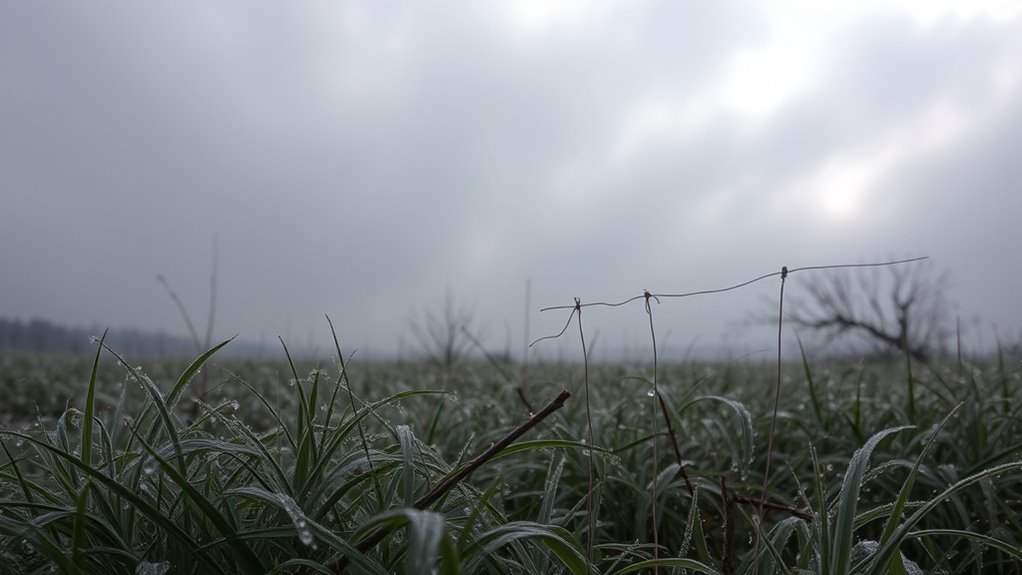
Wind and cloud cover play crucial roles in predicting frost because they directly influence surface temperatures. Wind removes the thin insulating layer of warm air near the ground, making frost more likely. Cloud cover blocks solar radiation during the night, preventing heat from escaping and keeping temperatures slightly higher. When winds die down and skies clear, temperatures can plummet, increasing frost risk. Soil moisture also impacts frost formation; moist soil retains heat longer, reducing frost chance, whereas dry soil cools rapidly. By observing wind patterns and cloud cover, you can better anticipate frost events. Keep an eye on:
- Calm, clear nights with little wind
- Sudden drops in wind speed
- Clear skies allowing maximum radiation loss
DIY Mechanical Frost Warnings Using Everyday Materials

You can create simple, effective frost warning devices using everyday materials, making it easier to monitor frost risk without relying on expensive equipment. One approach involves using waterproof materials to build a mechanical sensor that responds to temperature changes. For example, you can repurpose a small container, such as a plastic cup, and fill it with water or a liquid that expands as temperatures drop. Attach a lightweight indicator—like a paper strip or small metal piece—that moves when the liquid freezes or contracts. Incorporate solar lighting or reflective elements to make your device visible at night. Position your frost warning device in an open area, away from heat sources, so it accurately detects temperature drops. This DIY setup provides a low-cost, reliable method to anticipate frost without electricity.
Animal Behavior as an Indicator of Frost Risk
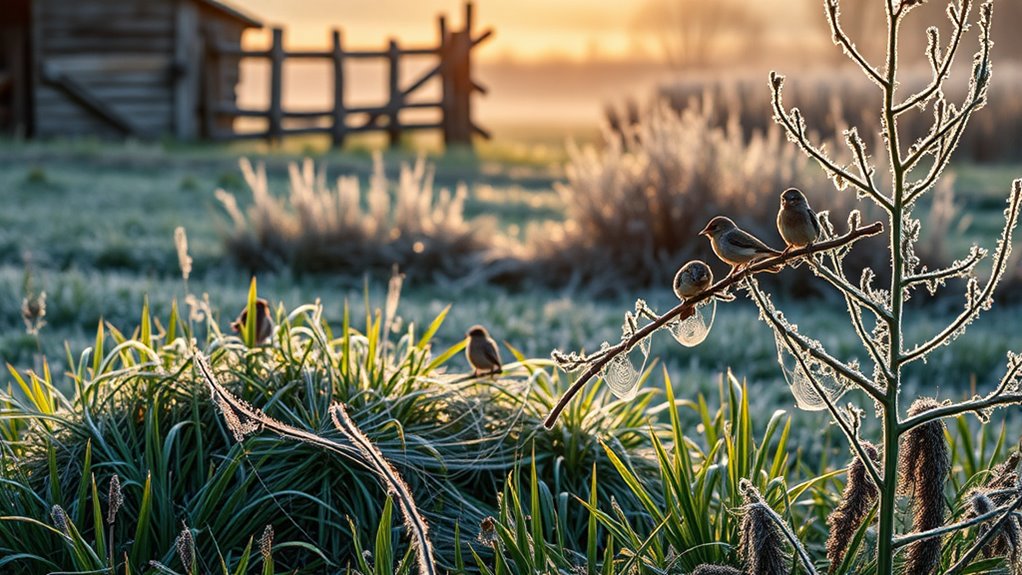
Animals often respond to dropping temperatures before frost becomes visible, making their behavior a valuable natural warning system. You can observe changes like increased animal migration or altered bird song cues, which signal an approaching cold snap. Birds may become quieter or cease singing, alerting you to prepare for frost. Similarly, animals might seek shelter or reduce activity earlier than expected. By paying close attention to these cues, you can anticipate frost risks without relying on modern devices. Noticing shifts in animal behavior provides an early warning, especially in rural or outdoor settings. This natural indicator helps you protect vulnerable plants and outdoor investments before the first frost arrives. Trusting these behaviors can be a simple, effective method for frost prediction without electricity.
Historical and Traditional Methods for Frost Prediction
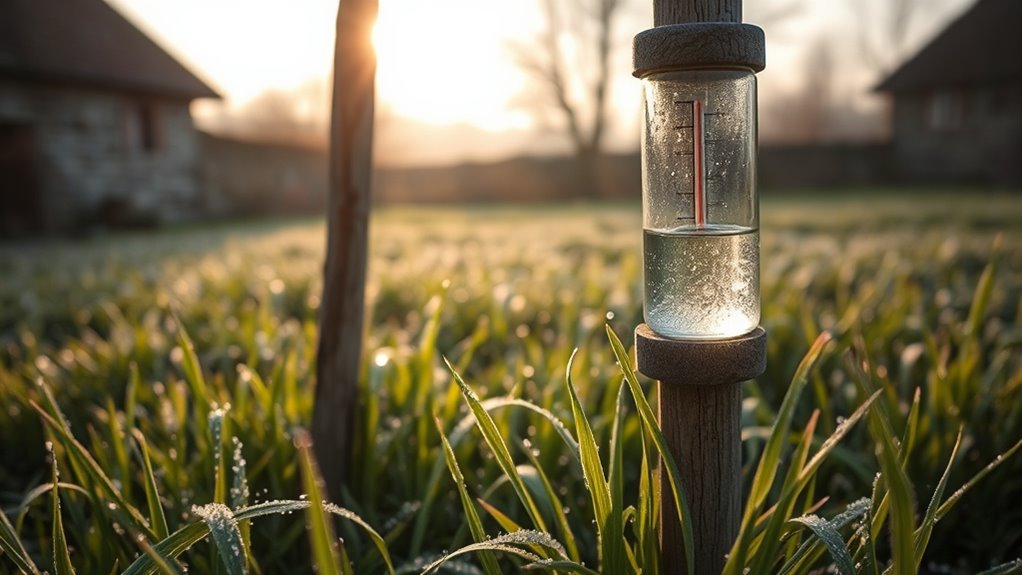
Throughout history, farmers and villagers have relied on traditional signs and observations to forecast frost, long before modern weather forecasting tools existed. One key method involves monitoring soil moisture, which influences how quickly the ground cools overnight. Dry soil loses heat faster, increasing frost risk, while moist soil retains warmth longer. Observing the level of solar radiation is also vital; clear, calm nights with minimal cloud cover allow more radiation to escape, causing temperatures to drop sharply. Farmers have historically watched for specific signs like dew formation or the behavior of plants and animals, which respond to changes in temperature and soil conditions. These age-old techniques, based on natural cues, remain valuable for predicting frost without electricity, especially in remote or traditional farming communities.
Frequently Asked Questions
How Reliable Are Natural Frost Pockets for Accurate Frost Prediction?
Natural frost pockets can be somewhat reliable for predicting frost because they reflect microclimate variability. You might notice these low-lying areas tend to freeze earlier, serving as natural indicators. However, their accuracy isn’t foolproof, since local conditions vary and other factors influence frost formation. While useful as a general guide, relying solely on frost pockets for precise predictions can be risky, so consider combining this method with other indicators for better accuracy.
Can Plant Responses Reliably Forecast Frost in Different Climates?
Think of plants as weather sensors, responding like a compass to their environment. Your observations of plant adaptation and frost resilience can reliably forecast frost in various climates, much like a seasoned sailor reading the stars. By understanding how different species react to cold, you gain a natural forecast tool. While not perfect, tracking plant responses offers a valuable, eco-friendly way to predict frost, especially in diverse climate zones.
How Do Weather Patterns Influence Traditional Frost Prediction Methods?
Weather patterns greatly influence traditional frost prediction methods by affecting microclimate variations and wind chill effects. You notice that changes in cloud cover, humidity, and air movement can signal upcoming frost, especially in localized areas. Wind chill effects can make temperatures feel colder, increasing frost risk. By observing these patterns, you can better anticipate frost without relying on electricity-dependent systems, making your predictions more reliable in diverse climates.
Are There Specific Animal Behaviors That Consistently Indicate Upcoming Frost?
Think of animals as nature’s early warning system. You might notice birds migrating earlier than usual or insects emerging in larger numbers—these behaviors often signal an approaching frost. For example, when you see swallows leaving sooner, it’s like nature’s alarm bell ringing. Such animal behaviors serve as reliable indicators, helping you prepare for frost without relying on electricity-based systems. Keep an eye on these signs to stay ahead of cold weather.
What Are the Limitations of DIY Frost Warning Devices Using Everyday Materials?
When creating DIY frost warning devices with everyday materials, you face material limitations that can hinder durability and effectiveness. Accuracy challenges also arise since simple tools might not precisely detect temperature drops or humidity changes. You might get false alarms or miss important frosts. While these devices are affordable and easy to assemble, they can’t match the reliability of professional systems, so always verify frost alerts with additional methods.
Conclusion
As night falls and the air turns still, your homemade frost warning tools become silent sentinels, quietly alerting you to nature’s subtle signals. A sudden shimmer of ice crystals or a hush in the wind may seem like coincidence, but it’s nature’s way of whispering that frost is near. Trust these simple, timeless methods—your eyes, instincts, and a touch of tradition—to keep your crops safe when electricity fades into the dawn.

